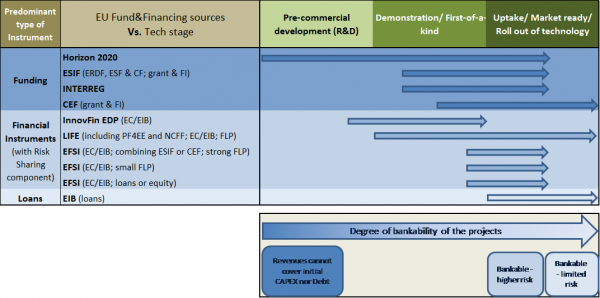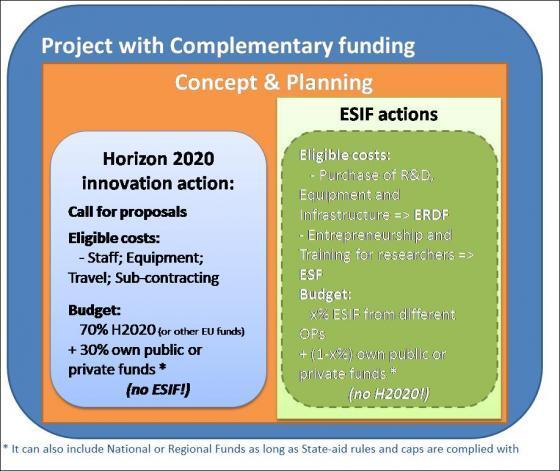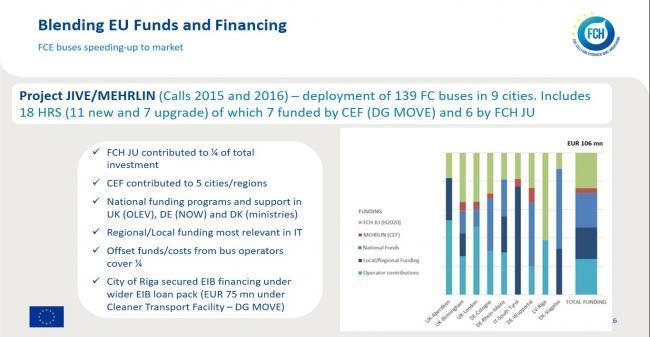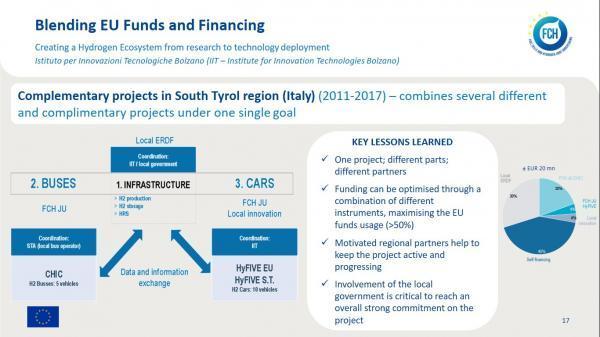Is EU funds blending possible?
Project Development Assistance (PDA)
Combination of funding (blending)
The table below provides some examples of funding and financing sources for projects according to their Technology Readiness Level as well as its degree of bankability. Due to the privileged relationship with the EIB in managing several European Commission financial instruments, and the specificity of each national promotional bank or commercial bank operating locally, the table only displays financing sources channelled via the EIB.
Glossary and links
Is EU funds’ blending possible?
As presented at the FCH JU’s 2017 call Infoday (underlined means link to presentation in PDF) as long as full compliance with the rules of each fund is ensured, it is possible to blend different EU funds to the same project or to its complimentary projects/activities.
Key principles to bear in mind are:
- Non-cumulative principle – no two sources of EU funding to the same expenditure item. The table below exemplifies expenditure items allocation to different EU funds to ensure no duplication (source: EC’s DG RTD)
- Co-financing principle – the EU funding is not to replace the minimum co-financing from the beneficiary (own public or private funds)
Ensuring full compliance with EU grants’ rules includes:
- A cost item is a specific expenditure incurred and eligible in a project
- In the same project, some expenditure may be co-funded under H2020 and other expenditure under ERDF, ESF or any other EU fund
- Part of “Personnel costs” can be funded under H2020 and other part under ESF
- Important to ensure accounting does not allow double funding of an expenditure and the promoter co-financing of one expense under H2020 is not included as eligible to other EU fund
Examples for blending EU Funds
- JIVE/MEHRLIN – two highly interconnected projects
Under the FCH JU Call 2016 and the CEF 2015 Call (running almost simultaneously), the projects JIVE/MEHRLIN were selected. The combined project deploys 139 Fuel Cell buses as well as 18 Hydrogen Refuelling Stations (HRS; 11 new and 7 upgrade) of which 7 funded by CEF (DG MOVE) and 6 by FCH JU.
As per the picture below, the project is also a clear example of the several different funding structures available for the 9 cities/regions involved, which depends markedly on the country/cities’ own framework for promoting investment.
- Complementary projects in South Tyrol region (Italy)
Istituto per Innovazioni Tecnologiche Bolzano (IIT – Institute for Innovation Technologies Bolzano) in the Italian region of South Tyrol combined several different and complimentary projects during 2011-2017 under one single goal: creating a Hydrogen Ecosystem from research to technology deployment.
The picture below breaks down the funding structure of the total investment (approx. EUR 20 million). While the H2020 fund managed by the FCH JU contributed with roughly ¼ of the total investment through two different projects (CHIC and HyFIVE), the ERDF was actually the main EU funding source to IIT’s overall project (30%).
Hubs and navigators
The Regions and Cities initiative has developed a EU funds navigator to assist you with identifying and learning about the various instruments at your disposal either as an entity that wishes to develop the technologies FCH JU devotes to or a region or city that wishes to deploy projects in their own local/regional community.
Funding and Financing Navigation Tool here.
Other hubs and navigators
Below you will find the links to other different EU funding and EIB financing hubs/navigators created to simplify the screening of EU funding and financing instruments available:
- YourEurope – Access to funding & financing
- EU funds funding tenders and EU Funds- funding opportunities
- Horizon 2020 Calls for proposals
- ESIF (DG REGIO)
- CEF- Connecting EUrope Facility (energy and transport)
- EIPP- European Investment Project Portal- the meeting place for project promoters and investors
- Innovation Radar tool – a data-driven online tool which provides easy access to innovations supported by EU funding and the innovators behind them
- EIAH – European Investment Advisory Hub
- Covenant of Mayors – Interactive funding guide – Financing opportunities for Sustainable Energy & Climate Action Plans
- Fi-Compass - platform for advisory services to managing authorities of EU funds, financial intermediaries or others on features, design and set-up of financial instruments under the European Structural and Investment Funds (ESIF)
- EIB products
- EIB advisory
- EIB financial intermediaries
- EIF (the European Investment Fund is part of the EIB Group) financial intermediaries
- EDA’s European Funding Gateway for Defence
Other links to other relevant publications on synergies between the several EU funds
- EC (GD REGIO)
- BBI JU
- CleanSky JU- Clean Sky working together with the Member States and Regions – Synergies with ESIF
On-going/Open calls (not exhaustive)
H2020 annual work programme 2018-2020:
- Secure, clean and efficient ENERGY
The Energy Challenge is designed to support the transition to a reliable, sustainable and competitive energy system. Info here
2018-2020 work programme – 10. Secure, clean and efficient energy. Info here
- Smart, Green and Integrated TRANSPORT
This Challenge aims to boost the competitiveness of the European transport industries and achieve a European transport system that is resource-efficient, climate-and-environmentally-friendly, safe and seamless for the benefit of all citizens, the economy and society.
2018-2020 work programme – 11. Smart, green and integrated transport
Project Development Assistance (PDA)
ELENA is a joint initiative by the EIB and the European Commission under the Horizon 2020 programme. ELENA provides grants for technical assistance focused on the implementation of energy efficiency, distributed renewable energy and urban transport projects and programmes.
The grant can be used to finance costs related to feasibility and market studies, programme structuring, business plans, energy audits and financial structuring, as well as to the preparation of tendering procedures, contractual arrangements and project implementation units.
Typically, ELENA supports programmes above EUR 30 million with a 3-year implementation period for energy efficiency and 4-year for urban transport and mobility, and can cover up to 90% of technical assistance/project development costs. Smaller projects can be supported when they are integrated into larger investment programmes. It requires a leverage effect of 20, which means for each euro of PDA another 20 will have to be added in the deployment stage of the project/programme.
The facility is ran continuously on a “first-come, first-served” basis.
Supports public and private project promoters building technical, economic and legal expertise needed for project development. Each project would be supported in between EUR 0.5 mn to EUR 1.5 mn (100% grant) during up to 3 years. Launching of concrete investments, before the end of the action and with a leverage factor of at least 15, is the final aim of any project supported under this call.
It differs from the ELENA support (EC/EIB) in the size (PDA goes for total investment plans of EUR 7.5-50 mn while ELENA is into >EUR 30 mn projects); co-funding rate (100% vs 90%); leverage effect (x15 vs. x20); and how potential beneficiaries apply to (one year call in open competition vs. ongoing application until budget is spent).
Although the 2018 call was closed on the 13th September 2018, it is expected that it reopens in the years to come until 2020.
Aims at receiving proposals (from consultancy firms) to set up and run a 'European City Facility' which offers financial support and services to cities and municipalities or their groupings (>100.000 inhabitants each). This support will enable a large number of cities and communities to develop their investment concepts for mobilising investments in sustainable energy. The budget earmarked for this is about EUR 10 mn and each of the entities supported (single or in groupings of municipalities) may receive a maximum lump sum of EUR 60,000 of services (cascade funding) within a short period (6-12 months).
A similar to the European City Facility call but this time dedicated to islands – to unlock financing for energy transitions and supporting islands to develop investment concepts.




